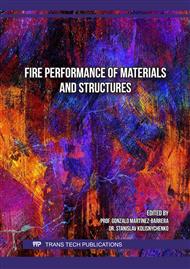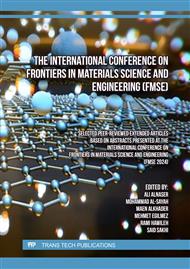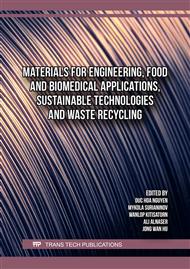[1]
A. Daware, M. Z. Naser, and G. Karaki, "Generalized temperature-dependent material models for compressive strength of masonry using fire tests, statistical methods and artificial intelligence," Architecture, Structures and Construction, vol. 2, no. 2, p.223–229, Jul. 2022.
DOI: 10.1007/s44150-021-00019-4
Google Scholar
[2]
H. Hostetter, M. Z. Naser, R. A. Hawileh, G. Karaki, and H. Zhou, "Enhancing fire resistance of reinforced concrete beams through sacrificial reinforcement," Architecture, Structures and Construction, vol. 2, no. 2, p.311–322, Jul. 2022.
DOI: 10.1007/s44150-022-00061-w
Google Scholar
[3]
R. A. Hawileh and V. K. R. Kodur, "Performance of reinforced concrete slabs under hydrocarbon fire exposure," Tunnelling and Underground Space Technology, vol. 77, p.177–187, Jul. 2018.
DOI: 10.1016/j.tust.2018.03.024
Google Scholar
[4]
M. Assad, R. A. Hawileh, and J. A. Abdalla, "Modeling the behavior of CFRP-strengthened RC slabs under fire exposure," Procedia Structural Integrity, vol. 42, p.1668–1675, 2022.
DOI: 10.1016/j.prostr.2022.12.210
Google Scholar
[5]
G. Karaki and M. Z. Naser, "An approach for developing probabilistic models for temperature-dependent properties of construction materials from fire tests and small data," Fire Mater, 2022.
DOI: 10.1002/fam.3116
Google Scholar
[6]
G. Karaki, R. Hawileh, and V. Kodur, "Probabilistic-Based Approach for Evaluating the Thermal Response of Concrete Slabs under Fire Loading," Journal of Structural Engineering, vol. 147, Apr. 2021.
DOI: 10.1061/(ASCE)ST.1943-541X.0003039
Google Scholar
[7]
M. Z. Naser, V. Kodur, H. T. Thai, R. Hawileh, J. Abdalla, and V. V. Degtyarev, "StructuresNet and FireNet: Benchmarking databases and machine learning algorithms in structural and fire engineering domains," Journal of Building Engineering, vol. 44, Dec. 2021.
DOI: 10.1016/j.jobe.2021.102977
Google Scholar
[8]
M. Assad, R. Hawileh, G. Karaki, J. Abdalla, and M. Z. Naser, "Assessment of critical parameters affecting the behaviour of bearing reinforced concrete walls under fire exposure," Journal of Structural Fire Engineering, 2023.
DOI: 10.1108/JSFE-07-2023-0029
Google Scholar
[9]
M. Assad, R. A. Hawileh, J. A. Abdalla, and F. Abed, "Heat Transfer Analysis of Reinforced Concrete Walls in ANSYS and ABAQUS: A Comparative Study," in 2022 Advances in Science and Engineering Technology International Conferences, ASET 2022, Institute of Electrical and Electronics Engineers Inc., 2022.
DOI: 10.1109/ASET53988.2022.9735001
Google Scholar
[10]
I. Almeshal, B. H. Abu Bakar, and B. A. Tayeh, "Behaviour of Reinforced Concrete Walls Under Fire: A Review," Fire Technology, vol. 58, no. 5. Springer, p.2589–2639, Sep. 01, 2022.
DOI: 10.1007/s10694-022-01240-3
Google Scholar
[11]
K. A. Mueller, Y. C. Kurama, and M. J. McGinnis, "Out-of-plane behavior of two reinforced concrete bearing walls under fire: A full-scale experimental investigation," ACI Struct J, vol. 111, no. 5, p.1101–1110, 2014.
DOI: 10.14359/51686814
Google Scholar
[12]
S. Lee and C. Lee, "Fire resistance of reinforced concrete bearing walls subjected to all-sided fire exposure," Materials and Structures/Materiaux et Constructions, vol. 46, no. 6, p.943–957, Jun. 2013.
DOI: 10.1617/s11527-012-9945-8
Google Scholar
[13]
J. A. Purkiss, Fire safety engineering design of structures, 2nd ed. Oxford: Butterworth-Heinemann, 2007.
Google Scholar
[14]
J. Chen, E. Hamed, and R. Ian Gilbert, "Structural Performance of Reinforced Concrete Walls under Fire Conditions," Journal of Structural Engineering, vol. 146, no. 3, p.04020006, Mar. 2020.
DOI: 10.1061/(asce)st.1943-541x.0002519
Google Scholar
[15]
K. T. Q. Nguyen, T. Ngo, P. Mendis, and D. Heath, "Performance of high-strength concrete walls exposed to fire," Advances in Structural Engineering, vol. 21, no. 8, p.1173–1182, Jun. 2018.
DOI: 10.1177/1369433217732500
Google Scholar
[16]
G. Karaki, R. A. Hawileh, and M. Z. Naser, "Impact of the variability of material constitutive models on the thermal response of reinforced concrete walls," Journal of Structural Fire Engineering, Apr. 2024.
DOI: 10.1108/JSFE-06-2023-0027
Google Scholar
[17]
Y. Q. Zheng and J. P. Zhuang, "Analysis on Fire Resistance of Reinforced Concrete Wall," Adv Mat Res, vol. 243–249, p.797–800, 2011.
DOI: 10.4028/www.scientific.net/AMR.243-249.797
Google Scholar
[18]
O'Meagher AJ and Bennetts ID, "Modelling of concrete walls in fire," Fire Saf J, 1991.
Google Scholar
[19]
Pothisiri T, Jongvivatsakul P, Chou S, and Wijeyewickrema AC, "Modeling of precast concrete load-bearing walls exposed to fire," Eng J, vol. 23, no. 6, p.433–449, 2019.
DOI: 10.4186/ej.2019.23.6.433
Google Scholar
[20]
ABAQUS. ABAQUS standard user's manual. Version 19, vol. I–III. Pawtucket (America): Hibbitt, Karlsson & Sorensen, Inc.; 2019.
Google Scholar
[21]
ASTM A370-18, 'Standard Test Methods and Definitions for Mechanical Testing of Steel Products,' 2018.
Google Scholar
[22]
T. Ngo, S. Fragomeni, P. Mendis, and B. Ta, "Testing of normal-and high-strength concrete walls subjected to both standard and hydrocarbon fires," ACI Struct J, vol. 110, no. 3, p.503–510, May 2013.
DOI: 10.14359/51685607
Google Scholar
[23]
EN 1992-1-2: Eurocode 2: Design of concrete structures - Part 1-2: General rules - Structural fire design, 1992.
Google Scholar




